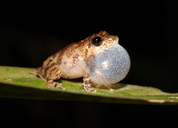|
Pseudophilautus mittermeieri (Meegaskumbura & Manamendra-Arachchi, 2005)
Mittermeier's Shrub Frog | family: Rhacophoridae subfamily: Rhacophorinae genus: Pseudophilautus |
| Species Description: Meegaskumbura M & Manamendra-Arachchi K 2005 Description of eight new species of shrub frogs (Ranidae: Rhacophorinae: Philautus) from Sri Lanka. Raffles Bull Zool Suppl 12:305-338. | |
 © 2012 Malaka Bopage (1 of 3) |
|
|
|
Description Pseudophilautus mittermeieri is a moderate-sized frog with snout vent length of 16.3 – 18.4 mm in males. The body is slender with a dorsally convex head. The snout-angle category is 4 or 5 (angle of snout 90º – 95º). The snout appears pointed in the lateral view. The canthal edges are round, while the loreal region is concave. The interorbital space and internasal space are concave. The distinct tympanum orients vertically. The supratympanic fold is distinct. Pseudophilautus mittermeieri lacks the following features: pineal ocellus, vomerine ridge, cephalic ridges, lingual papilla and co-ossified skin on skull. The fingers have lateral dermal fringe. The toes are webbed. The tarsal folds and calcar are present. There are glandular warts located on the following features: snout, interorbital space, side of head and dorsum, both upper and lower flank. The dorsal part of forelimb, thigh, shank and pes are smooth. The throat, chest, belly and underside of thigh are granular. Males have inner vocal slits. Nuptial pads are absent (Meegaskumbura & Manamendra-Arachchi 2005). In life, the middle part of the dorsum is a dark ashy-olive. The tubercles on the head are orange. Posteriorly, the back has orange pigments. The side of head is ashy brown. The supratympanic fold is orangish-light brown. The lower lip is ash in color. The inguinal region is dark brown. The flank is ashy-yellow with dark brown patches. The anterior thigh has dark brown cross markings. The posterior thigh and tibia are dark brown. The throat, chest, and upper abdomen are ash and the lower abdomen is ashy-yellow. In the ventral view, the fingers are ash in color. There are varying amounts of dark ashy brown crossbars located on the following features: lower arm (4), thigh (3), and shank (3). The ventral area of thigh, shank, pes and toes are dark brown. The venter is yellow (Meegaskumbura & Manamendra-Arachchi 2005). In preservative, the dorsal side of the head and body are grey with brown patches. There are brown pigments on the grey upper and lower flanks. The upper lip and loreal region are grey. The inguinal zone is dark brown. The tympanic region and tympanum are grey with brown pigments. In the dorsal view, the limbs are grey, with indistinct bars (Meegaskumbura & Manamendra-Arachchi 2005). Distribution and Habitat Country distribution from AmphibiaWeb's database: Sri Lanka
Pseudophilautus mittermeieri's habitat is primarily in the lowland wet zone at an elevation below 200 m (Meegaskumbura & Manamendra-Arachchi 2005; Batuwita et al. 2019). Life History, Abundance, Activity, and Special Behaviors Pseudophilautus mittermeieri are habitat specialists located in the shrub understory of closed-canopy lowland rainforests. At night, males vocalize in chorus from leaves (up to ~ 1 m above ground) (Meegaskumbura & Manamendra-Arachchi 2005). All frogs of this genus Pseudophilautus are terrestrial direct developers (Bahir et al. 2005). Possible reasons for amphibian decline General habitat alteration and loss Comments The species epithet of Pseudophilautus mittermeieri is named after the President of Conservation International, Russell Mittermeier. He was chosen because of his commitment to the Global Amphibian Assessment and support of the conservation of amphibians worldwide (Meegaskumbura & Manamendra-Arachchi 2005). The sister species of Pseudophilautus mittermeieri is P. decoris. The two species are differentiated by a 12S and 16S divergence of 2.38%. A 5.80% divergence was found using a cytochrome-b sequence between the two sister species further differentiating them (Meegaskumbura & Manamendra-Arachchi 2005).
References
Bahir, M. M., Meegaskumbura, M., Manamendra-Arachchi, K., Schneider, C. J., and Pethiyagoda, R. (2005). ''Reproduction and terrestrial direct development in Sri Lankan shrub frogs (Ranidae: Rhacophorinae: Philautus).'' The Raffles Bulletin of Zoology, 12, 339-350. [link] Batuwita S, Udugampala S, DeSilva M, Diao J and Edirisinghe U. (2019). "A review of amphibian fauna of Sri Lanka: distribution, recent taxonomic changes and conservation." Journal of Animal Diversity, 1(2), 44-82. [link] Meegaskumbura M. & Manamendra-Arachchi K. (2005). ''Description of eight new species of shrub frogs (Ranidae: Rhacophorinae: Philautus) from Sri Lanka.'' Raffles Bulletin Zoology Supplemental, 12, 305-338. [link] Originally submitted by: Dayupathi Eranda Nipunika Mandawala (2021-09-26) Description by: Dayupathi Eranda Nipunika Mandawala, Arjun Mehta (updated 2021-10-12)
Distribution by: Dayupathi Eranda Nipunika Mandawala, Arjun Mehta (updated 2021-10-12)
Life history by: Dayupathi Eranda Nipunika Mandawala, Arjun Mehta (updated 2021-10-12)
Comments by: Dayupathi Eranda Nipunika Mandawala, Arjun Mehta (updated 2021-10-12)
Edited by: Michelle S. Koo, Arjun Mehta (2021-10-12) Species Account Citation: AmphibiaWeb 2021 Pseudophilautus mittermeieri: Mittermeier's Shrub Frog <https://amphibiaweb.org/species/6515> University of California, Berkeley, CA, USA. Accessed Jun 1, 2025.
Feedback or comments about this page.
Citation: AmphibiaWeb. 2025. <https://amphibiaweb.org> University of California, Berkeley, CA, USA. Accessed 1 Jun 2025. AmphibiaWeb's policy on data use. |



 Map of Life
Map of Life